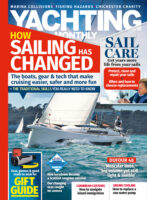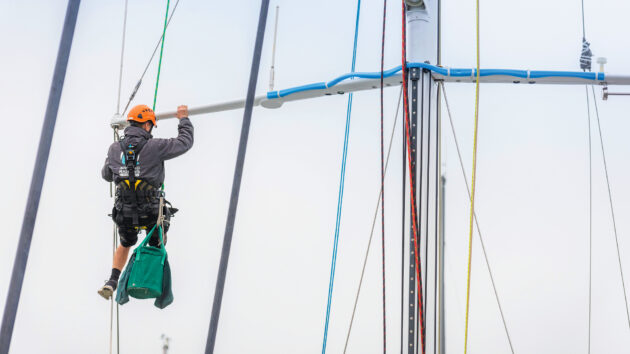When planning a long-distance passage, confidence in the integrity of your yacht’s rig is essential for both safety and peace of mind at sea.
When planning a long-distance passage, confidence in the integrity of your yacht’s rig is essential for both safety and peace of mind at sea. Unlike weekend cruising, extended passages expose your yacht to sustained and sometimes extreme stresses. Continuous loading, dynamic movement in large swells, and the relentless fatigue caused by long periods of downwind sailing all conspire to accelerate wear and highlight any weaknesses in your rigging system.
This can exploit the most minor of flaws in your rigging, fittings, or hardware, turning them into serious failures unless the system is properly prepared in advance and monitored with vigilance throughout the journey.
Pre-Departure Planning
Before setting sail, a comprehensive rig inspection by a qualified and experienced professional is strongly advised. In fact, many insurance providers now require documented evidence of such an inspection before granting offshore coverage. Ideally, this check should be carried out in your home port, giving you time to complete any necessary repairs or replacements without any logistical pressure.
Depending on the rig’s age, type, and maintenance history, the scope of the inspection can vary. For newer rigs or those with detailed service records, a visual inspection aloft may suffice. Older or heavily used systems may warrant a full mast unstepping and rig-out survey. This allows riggers to inspect components not easily seen from deck level, such as mast step fittings, sheave blocks and internal wiring.
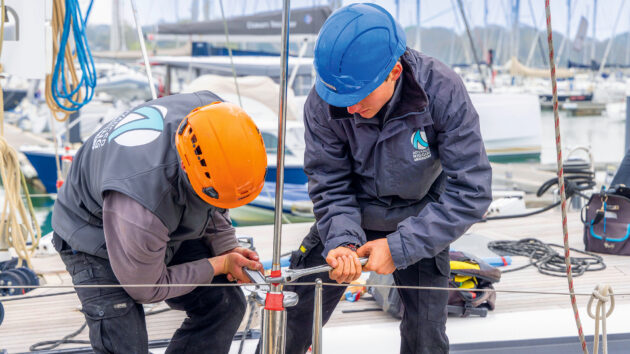
A comprehensive rig inspection by qualified professionals is strongly advised
Skippers and crew should be present and involved in the inspection process. It’s an excellent opportunity to gain hands-on understanding of your yacht’s rigging setup. Don’t be afraid to ask questions, take notes, or request clarification. Obtain a written inspection report that outlines findings, highlights wear areas, and lists any parts replaced or flagged for future attention. This documentation not only helps guide ongoing maintenance, but may also serve as critical evidence in the case of insurance claims or warranty issues down the line.
If possible, arrange a secondary check shortly before departure.
Spares and Tools
Once offshore, you are your own support system. That means having a well-considered inventory of spares and tools is absolutely essential. A small issue that would be a quick fix in port can escalate offshore if the right components or equipment aren’t on hand.
Your spares kit should include essentials such as split pins, clevis pins, shackles, lashings, and mechanical terminals, along with Dyneema strops, rigging tape, spare halyards, and friction rings.
Article continues below…
Yacht rigging: your essential pre-season rig check guide
During the spring fit-out we often appear to lavish far more attention on the engine and electrical systems than we…
Troubleshooting problems with your yacht rigging
Yacht rigging is a dark art and no one will ever convince me otherwise. I have yet to meet two…
Just as critical as your tools are your tools. Ensure bolt croppers, spanners, screwdrivers, and adjustable wrenches are clean, rust-free, and within easy reach. It’s not uncommon for tools to end up buried in the bottom of a lazarette, only to be discovered in poor condition when they’re urgently needed.
Think practically: where will you go looking for these items when the boat is pitching in a 4m swell?
And while a mast climb at sea is a last resort, your crew must be confident in their ability to do so if the need arises. Practice climbing the rig while you are safely in port. Establish a clear communication protocol between the person going aloft and the team down on the deck – and always double-check all of the boat’s climbing equipment for wear. It will help if you photograph key areas at the masthead, spreaders and gooseneck before departure to provide a visual reference for comparison if issues arise underway.
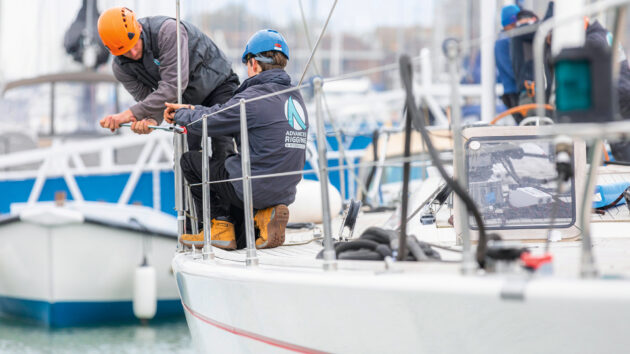
Fasteners should be checked for tightness and cotter pins must be secure
Pre-Voyage Deck-Level Inspection
In the days before departure, a systematic deck-level rig inspection is essential. This should be conducted with full crew participation. Walk through your standing and running rigging, furling gear, chainplates, turnbuckles, and deck fittings from bow to stern. Create or refer to a rigging checklist specific to your yacht and its setup, paying attention to areas that are known to work hard under load.
Fasteners should be checked for tightness. Cotter pins must be secure, opened correctly, and taped to avoid snagging. Inspect sheets and halyards for chafing, particularly near clutches, exit sheaves, and where lines bear against the mast or rigging. Look for any signs of UV (ultraviolet) degradation, corrosion, or unexpected movement. Check tension systems for signs of stretch or imbalance, and confirm that the sheaves turn freely under load.
Routine Checks Under Way
Once you’re out at sea, daily rig inspections will be your best defence against any failures. These needn’t be complex or time-consuming. A simple five-minute check during each watch change will be enough to catch most early signs of wear.
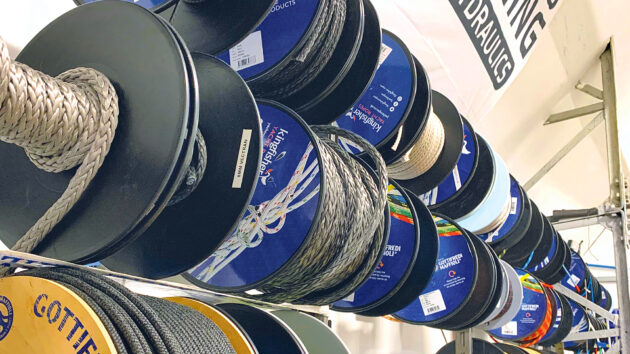
Your spares kit should include replacement halyards
Encourage every crewmember to get involved – when the whole crew is alert to potential issues, the boat stays safer. Use a pair of binoculars to examine the masthead and spreaders, and run your fingers over shrouds and stays to feel for any strand separations or unusual tension. Listen out for unexpected noise or vibration when under sail. Lines and hardware that were static in port will now move constantly. Watch for signs of chafing, heat build-up, or wear, especially in reefing systems, preventers, and boom control lines. Trade wind sailing in particular creates a repetitive, rolling motion that can rub through lines in a matter of hours if left unchecked.
Post-Passage Inspection
After arrival, it’s easy to let your guard down. But before you decide to relax with a rum punch on a sandy beach, it’s crucial that you give your rig one last check.
Use your original inspection checklist and compare it with your pre-departure notes and photographs. Look for signs of elongation in terminals, signs of new movement in deck hardware, or wear in halyards and sheaves. Document any changes, and if you’re continuing onwards, schedule any necessary repairs to be carried out before you leave. This is also an excellent opportunity to evaluate how well your systems performed under real ocean conditions – and what could be improved for the next leg.
Enjoyed reading this?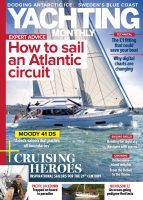
A subscription to Yachting Monthly magazine costs around 40% less than the cover price, so you can save money compared to buying single issues.
Print and digital editions are available through Magazines Direct – where you can also find the latest deals.
YM is packed with information to help you get the most from your time on the water.
-
-
- Take your seamanship to the next level with tips, advice and skills from our experts
- Impartial in-depth reviews of the latest yachts and equipment
- Cruising guides to help you reach those dream destinations
-
Follow us on Facebook, Twitter and Instagram.
Note: We may earn a commission when you buy through links on our site, at no extra cost to you. This doesn’t affect our editorial independence.

